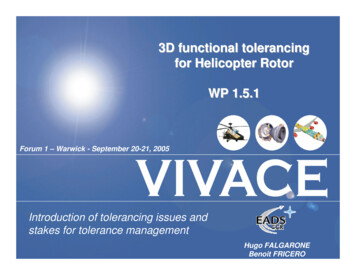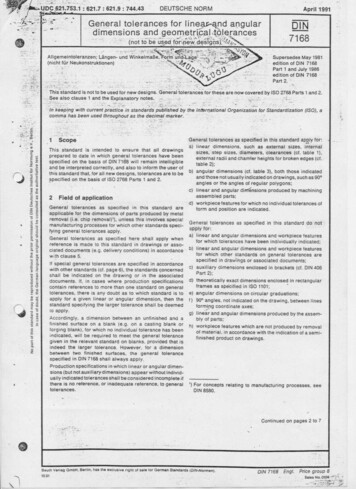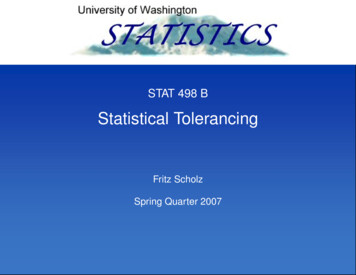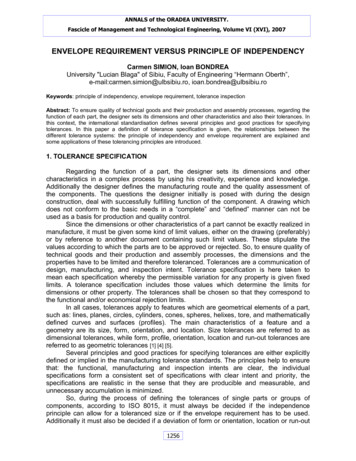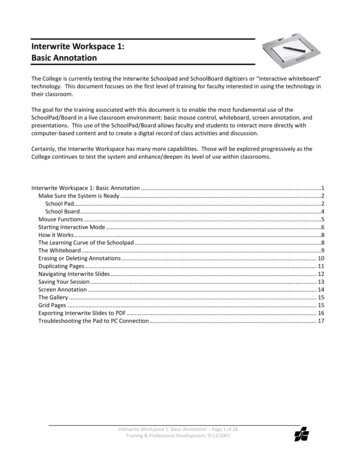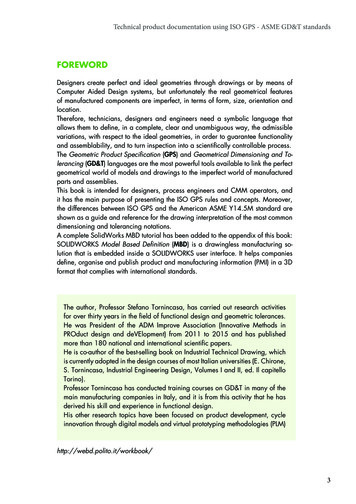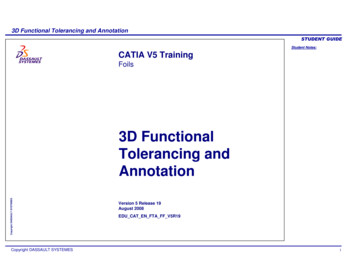
Transcription
3D Functional Tolerancing and AnnotationCATIA V5 TrainingStudent Notes:FoilsCopyright DASSAULT SYSTEMES3D FunctionalTolerancing andAnnotationCopyright DASSAULT SYSTEMESVersion 5 Release 19August 2008EDU CAT EN FTA FF V5R191
3D Functional Tolerancing and AnnotationAbout this courseStudent Notes:Objectives of the courseUpon completion of this course you will be able to:- Add 3D annotations to a part- Manage and position these annotations- Create and manage annotation planes and views- Manage the 3D geometry associated to the 3D annotationsTargeted audienceMechanical DesignersPrerequisitesCopyright DASSAULT SYSTEMESStudents attending this course should be familiar with- Basics of Solids and Surfaces creation.- Basics of Knowledgeware.Copyright DASSAULT SYSTEMES2 Days2
3D Functional Tolerancing and AnnotationStudent Notes:Table of Contents (1/3)Introduction to FT&AWhy do we need Geometrical Tolerances and AnnotationsHow to Generate AnnotationsBasic Concepts of FTAUnique Tolerancing ChannelGetting Familiar With FTA WorkbenchTo Sum UpThe Tolerancing AdvisorCopyright DASSAULT SYSTEMESWhat is Tolerancing AdvisorDifferent ISO Standards RulesCreating DatumsCreating Semantic AnnotationsN Elements TolerancingCreating Non-Semantic AnnotationsCreating Framed DimensionsTo Sum Up67810162429303132374554626773Creating & Managing FTA Annotations74Creating View/Annotation Planes75Copyright DASSAULT SYSTEMES3
3D Functional Tolerancing and AnnotationStudent Notes:Table of Contents (2/3)Aligned Section Views and Section CutsOffset Section view / Section CutEditing and Managing AnnotationsManaging CapturesGenerating Check ReportTo Sum UpGeometry for 3D AnnotationsCreating Constructed GeometryGeometry Connection ManagementTo Sum UpCopyright DASSAULT SYSTEMESAdvanced FunctionsWhat are Restricted AreasHow to Create Restricted AreasHow to Create Datum TargetsCreating Thread RepresentationsHow to Create Thread RepresentationHow to Create Knowledge Formulas on TolerancesTo Sum UpCopyright DASSAULT 281291324
3D Functional Tolerancing and AnnotationStudent Notes:Table of Contents (3/3)The User ght DASSAULT SYSTEMESFTA Settings - TolerancingFTA Settings - DisplayFTA Settings - Constructed GeometryFTA Settings - ManipulatorsFTA Settings - DimensionFTA Settings - AnnotationFTA Settings - TolerancesFTA Settings - View/Annotation PlaneThe Infrastructure SettingsGenerative Drafting SettingsCo-ordinate Dimension Display SettingsTo Sum Up133Copyright DASSAULT SYSTEMES5
3D Functional Tolerancing and AnnotationIntroduction to FT&AStudent Notes:You will become familiar with the concepts behind 3D Functional Tolerancing &Annotation workbenchCopyright DASSAULT SYSTEMESWhy do we need Geometrical Tolerances and AnnotationsHow to Generate AnnotationsBasic Concepts of FTAUnique Tolerancing ChannelGetting Familiar With FTA WorkbenchTo Sum UpCopyright DASSAULT SYSTEMES6
3D Functional Tolerancing and AnnotationWhy do We Need Geometrical Tolerances and AnnotationsStudent Notes:Designers create parts that are generallyrequired to create an assembly of a particularproduct. Each part will be engineered toperform a function and, most importantly, toassemble with a mating part.Thus every part should EXACTLY FIT in thefinal assembly and answer the requestedfunctions.Parts cannot be manufactured to exact sizesbecause of natural imperfections in the world,including machine tools, part programs,tooling, and also human errors. So a plan isneeded to allow the production process toaccept the imperfections. This gave rise to theconcept of “Tolerancing” or “AllowableDeviation”.Copyright DASSAULT SYSTEMESA tolerance is the amount of deviation from the exact size allowed on a part. Any part withinthe tolerance will still be functional.Designers need to set part tolerances that are large enough to keep manufacturing costsdown and close enough to ensure that all parts will assemble with the mating part.It is easy for the designer to use a close tolerance on features to reduce part dimensionvariables; however the part cost increases dramatically as tolerances are reduced.Copyright DASSAULT SYSTEMES7
3D Functional Tolerancing and AnnotationStudent Notes:How to Generate Annotations (1/2)Identify the Geometrical Features of the mechanismIdentify the ‘Use Aptitude Conditions’The ‘Use Aptitude Conditions’ are the functional requirement conditionsidentified during the functional analysis of the mechanism.Here is a mechanism with ‘Use Aptitude Conditions’ to respect:UAC 1: Radial gap 0.1mmUAC 2: Axial gap 3mmUAC 2Copyright DASSAULT SYSTEMESUAC 1Copyright DASSAULT SYSTEMES8
3D Functional Tolerancing and AnnotationStudent Notes:How to Generate Annotations (2/2)UAC 1UAC 2Copyright DASSAULT SYSTEMESUAC 1Copyright DASSAULT SYSTEMESUAC 2Radial gap 0.1mmAxial gap 3mm9
3D Functional Tolerancing and AnnotationStudent Notes:Basic Concepts of FTAIn this section, you will be introduced to the basic concepts of Functional Tolerancingand Annotations.Real worldCopyright DASSAULT SYSTEMESVirtual worldCopyright DASSAULT SYSTEMES10
3D Functional Tolerancing and AnnotationStudent Notes:Industrial Objectives‘Invent & create innovative products which meet customersrequirements, fit functions & can be produced with a high levelof quality, best cost & within time.’Copyright DASSAULT SYSTEMESGeometrical variationsAs BuiltCopyright DASSAULT SYSTEMESMeans of ProductionAs Designed11
3D Functional Tolerancing and AnnotationStudent Notes:Tolerancing Purpose“A bridge between the virtual & real world”Copyright DASSAULT SYSTEMESVirtual worldCopyright DASSAULT SYSTEMESReal worldEX:Need: Describe the non-ideal geometryAcceptable Interval of tolerance12
3D Functional Tolerancing and AnnotationStudent Notes:Tolerancing Scope“Transversal topic: Dimensional Management in the Product DevelopmentProcess”DDesignVoice of CustomerCopyright DASSAULT SYSTEMESQQualityCopyright DASSAULT SYSTEMESCManufacturing13
3D Functional Tolerancing and AnnotationCurrent Tolerancing SituationStudent Notes:Pains:High cost of Manufacturing due to over quality.High rate of faulty parts produced.Products not complying with customer requirements.Major Engineering changes in the final stages of the project.Objectives:Products which fit the customers’ requirements and can be produced.Product and Process optimization.Copyright DASSAULT SYSTEMESFacilitate transversal collaborative work.Copyright DASSAULT SYSTEMES14
3D Functional Tolerancing and AnnotationPotential Tolerancing ImprovementsStudent Notes:Copyright DASSAULT SYSTEMES“Create a unique Tolerancing channel”Copyright DASSAULT SYSTEMES15
3D Functional Tolerancing and AnnotationUnique Tolerancing ChannelStudent Notes:Copyright DASSAULT SYSTEMESThis skillet explains the limitations in the current design process and provides with avalue proposal and gives a strategy to implement it.Copyright DASSAULT SYSTEMES16
3D Functional Tolerancing and AnnotationTransversal Topic:Student Notes:Copyright DASSAULT SYSTEMESLets have a look for Design purposeCopyright DASSAULT SYSTEMES17
3D Functional Tolerancing and AnnotationStudent Notes:Usual Design Process:1Geometrical DefinitionUse Aptitude Conditions234Initial Drawings & write2D annotationsSelect & ValidateTolerancing schemaValidate DrawingsCopyright DASSAULT SYSTEMES5Copyright DASSAULT SYSTEMES18
3D Functional Tolerancing and AnnotationHighlights of Current Design Process:Student Notes:Pains:Drawing as master:Annotations not linked with 3D geometry.Consistency between 2D Drawings & 3D Geometry costs a lot.Risk of mistakes, oblivion & misunderstanding.Tolerances and dimensions redefined & converted several times in the product Development process.Value Proposal:Create & Manage 3D Annotations attached to the 3D geometry.Drawing as result, 3D as master.3D Annotations used and shared along the product life cycle.Copyright DASSAULT SYSTEMESAdded high value:Capturing, sharing and re-applying corporate knowledge.Copyright DASSAULT SYSTEMES19
3D Functional Tolerancing and AnnotationStudent Notes:New Design Process - FTA Way (1/4)1Geometrical Definition23Copyright DASSAULT SYSTEMES4Use Aptitude ConditionsWrite 3D AnnotationsSelect & ValidateTolerancing schema5Generate drawings & Lookthrough 3D annotation duringdigital mock up review processCopyright DASSAULT SYSTEMES20
3D Functional Tolerancing and AnnotationNew Design Process - FTA Way (2/4)Student Notes:Design StrategyTo allow 3D only process:Specification: Dimensioning, Tolerancing, Notes, 3D annotations Communication and ReviewTo improve Dimensional Quality:Tolerance AnalysisTolerance SynthesisTo be used by Downstream Applications:Manufacturing (tolerance charting)Assembly process planningInspection, MetrologyCompany internal applicationsCopyright DASSAULT SYSTEMESTo define and support new standards for 3D annotations:ASME Y14.41-2003ISO/TC 213/WG 14Copyright DASSAULT SYSTEMES21
3D Functional Tolerancing and AnnotationNew Design Process - FTA Way (3/4)Student Notes:2D creationCopyright DASSAULT SYSTEMES3D GeometricalmodificationCopyright DASSAULT SYSTEMES2D UpdateOn Update: 2D geometry and annotations aremodified22
3D Functional Tolerancing and AnnotationNew Design Process - FTA Way (4/4)Student Notes:Main CharacteristicsFundamentals (Editor)Creation of annotations without semantic and syntactic control (Industry Standards)Linked to the 3D geometryAll Interactive Drafting dress-up capabilitiesCopyright DASSAULT SYSTEMESAdvanced (Advisor)Proposal of applicable tolerance types regarding the selected surfacesProposal of tolerance options when applicableTolerancing rules verificationAutomatic support of annotation syntax (GD&T)GUARANTEES of semantic & syntactic (Industry Standards) validity of the tolerancing, throughthe part / assembly life cycleCopyright DASSAULT SYSTEMES23
3D Functional Tolerancing and AnnotationGetting Familiar With FTA WorkbenchStudent Notes:Copyright DASSAULT SYSTEMESYou will become familiar with the User Interface of Functional Tolerancing &Annotations workbench.Copyright DASSAULT SYSTEMES24
3D Functional Tolerancing and AnnotationScope of Functional Tolerancing and AnnotationsStudent Notes:3D Functional Tolerancing & Annotation workbenches allows you to define andmanage 3D tolerance specifications and annotations directly on 3D parts or products.As discussed earlier, FTA reduces the reliance on 2D drawings and considers 3D as the masterrepresentation. Thus, driving the engineering process from design phase to manufacturing phase.In CATIA, Workbenches are dedicated for the followingFunctional Tolerancing & AnnotationThis Workbench is used for creating Tolerances on Parts in isolationProduct Functional Tolerancing & AnnotationThis Workbench is used for creating Tolerances on ProductsProcess Tolerancing & AnnotationThis Workbench is used for creating Tolerances on ProcessesTolerances on ProductsCopyright DASSAULT SYSTEMESTolerances on PartsCopyright DASSAULT SYSTEMES25
3D Functional Tolerancing and AnnotationStudent Notes:Accessing the WorkbenchIt is possible to work with FTA at Part, Product and Process level in any CATPart,CATProduct and CATProcess document respectively.Part Level FTAProduct Level FTACopyright DASSAULT SYSTEMESProcess Level FTACopyright DASSAULT SYSTEMES26
3D Functional Tolerancing and AnnotationThe User Interface – Part LevelStudent Notes:Copyright DASSAULT SYSTEMESYou can access the following annotations tools through Insert Menu for Part level FTACopyright DASSAULT SYSTEMES27
3D Functional Tolerancing and AnnotationStudent Notes:The FTA ToolbarsSpecific Product Functional Tolerancing & Annotation and Functional Tolerancing &Annotation ToolbarsNote Object AttributeAnnotationTolerancing CreationGroupingViewsCopyright DASSAULT SYSTEMESVisualizationReportingTolerancing AnalysisCaptureGeometry for 3D annotationsReference Elements** Only available on FTA environmentTolerancing Graphical ManagementCopyright DASSAULT SYSTEMESTolerancing Geometrical Management28
3D Functional Tolerancing and AnnotationTo Sum UpStudent Notes:You have seen:Copyright DASSAULT SYSTEMESHow FTA helps to bridge the gap between Real and Virtual world.The New Design process using FTA.The User interface of FTA workbenchCopyright DASSAULT SYSTEMES29
3D Functional Tolerancing and AnnotationThe Tolerancing AdvisorStudent Notes:In this lesson you will learn how the Tolerancing Advisor facilitates creation ofTolerances, Datum features, Semantic and Non- Semantic Annotations.Copyright DASSAULT SYSTEMESWhat is Tolerancing AdvisorDifferent ISO Standards RulesCreating DatumsCreating Semantic AnnotationsN Elements TolerancingCreating Non-Semantic AnnotationsCreating Framed DimensionsTo Sum UpCopyright DASSAULT SYSTEMES30
3D Functional Tolerancing and AnnotationStudent Notes:What is Tolerancing Advisor?The Tolerancing Advisor is a tool to specify 3D annotations on a product. It is a wizardthat assists you to create permissible annotations according to the selected geometricalelement or existing annotation.It 'Proposes'all possible Annotations and Tolerances that can be applied on theselected surface.It helps to verify Tolerancing Rules.Guarantees you the correctness of all the annotations with the standards used usingsyntactic and semantic verifications.Copyright DASSAULT SYSTEMESWhen thissurface isselected.When thisEdge isselected.The example explains how the Dialog Box changes when the selection changes, displaying onlypermissible tolerances.Copyright DASSAULT SYSTEMES31
3D Functional Tolerancing and AnnotationStudent Notes:Different ISO Standards Rules (1/5)International Organization For Standardization Rules Number 406.1987: These Standardsare used to set Tolerances for linear and angular dimensions in technical drawings.ElementsType of TolerancesIsolated elementsDimensionalSymbolsLinearAngularCopyright DASSAULT SYSTEMES(1 to N Elements)Tolerancing characteristicsCopyright DASSAULT SYSTEMES32
3D Functional Tolerancing and AnnotationStudent Notes:Different ISO Standards Rules (2/5)International Organization For Standardization Rules Number 1101.1983:ElementsType of TolerancesTolerancing characteristicsSymbolsStraightnessFlatnessIsolated ineIsolated or associated rpendicularityAngularityCopyright DASSAULT SYSTEMESAssociated elementsCopyright DASSAULT etryRunoutCircular RunoutTotal Runout33
3D Functional Tolerancing and AnnotationStudent Notes:Different ISO Standards Rules (3/5)International Organization For Standardization Rules Number 1101.1983:Powertrain case StudyRunout specificationProfile specificationFunctional Tolerancing for connecting rodCopyright DASSAULT SYSTEMESContextOrientation &positionspecificationsCopyright DASSAULT SYSTEMES34
3D Functional Tolerancing and AnnotationStudent Notes:Different ISO Standards Rules (4/5)International Organization For Standardization Rules Number 5459.1981:Reference Frame DatumDatum Frame:Element not used as Reference FrameDatum, but needed to createReference Frame Datums (see next page)Reference Frame Datum:Copyright DASSAULT SYSTEMESReference Frame datum onan ideal surfaceCopyright DASSAULT SYSTEMESDatum FrameReal SurfaceReal Surface on Marble ControlReference FrameDatum: Plane set bymarbleReference FrameDatum simulated:Surface of marble35
3D Functional Tolerancing and AnnotationStudent Notes:Different ISO Standards Rules (5/5)International Organization For Standardization Rules Number 5459.1981:There are 3 kinds of Reference Frame Datum:Simple Reference Frame Datum (see previous slide)Specified Reference Frame DatumCopyright DASSAULT SYSTEMESCommon Reference Frame DatumCopyright DASSAULT SYSTEMES36
3D Functional Tolerancing and AnnotationCreating DatumsStudent Notes:Copyright DASSAULT SYSTEMESIn this skillet you will learn the basic principles behind creating Datum Elements andDatum System.Copyright DASSAULT SYSTEMES37
3D Functional Tolerancing and AnnotationWhat is Datum (1/2)Student Notes:Datums are used to identify the datum element in the tolerance frame, specified incase of geometrical tolerancing and on form tolerancing. The Datum element maybe a face of a part. The face marked with Datum, indicates that the face will be areference face and other faces will be machined with respect to this face. A capitalletter is used to identify the datum element.You can specify Datums by following three methods:Simple Datum elementsSpecified Datum systemsCommon Datum elementsCopyright DASSAULT SYSTEMESDatum System CompositionWhen only one identifier is specified in the tolerance frame, the datum is asingle datum.When the identifiers are specified separately in each frame of the toleranceframe, the datum elements represent a datum system. Reference A is theprimary datum and reference B is the secondary datum. Using this datumsystem, fitting will be performed first on datum A, then on datum B, withrespect to A.When two identifiers separated by a dash are specified in the tolerance frame,the datum is a common datum. The two datum elements are to be consideredsimultaneously.Copyright DASSAULT SYSTEMES38
3D Functional Tolerancing and AnnotationStudent Notes:What is Datum (2/2)Simple DatumelementsThe faces are Datum Faces and indicatedwith Simple Datum Elements. The Hole willbe machined with Datum A and Datum Bfaces.Specified DatumsystemsHole position with respect to the systemcomposed of the face A and face B correctlypositioned respectively to face A.Copyright DASSAULT SYSTEMESCommon DatumelementsCopyright DASSAULT SYSTEMESMiddle portion of the shaft is concentricwith Datum Faces A and B simultaneously.39
3D Functional Tolerancing and AnnotationHow to Create Simple Reference Datum ElementStudent Notes:You will use the Tolerancing Advisor to create simple Reference Datum13Select the TolerancingAdvisor iconThe Semantic Tolerancing Advisor dialogbox is displayed.Select the Datum icon.2Select the element that should be Datum.In this example, a face is selected4Enter the label & validate the creationCopyright DASSAULT SYSTEMESClick to create datumreference frameCopyright DASSAULT SYSTEMESObserve therepresentation in thespecification tree40
3D Functional Tolerancing and AnnotationHow to Create Specified Reference Datum Element (1/2)Student Notes:In order to create Common Reference Frame Datum, Simple Reference Datumshave to be created before.1Select the Tolerancing Advisor icon2Click on ‘Add’ to create New ReferenceFrame DatumThe Dialog Box showspreviously createdReference FramesSelect the Primary Reference DatumCopyright DASSAULT SYSTEMES3Copyright DASSAULT SYSTEMES4Select the Secondary Reference DatumRepeat the step 4 for thetertiary reference, if needed.41
3D Functional Tolerancing and AnnotationHow to Create Specified Reference Datum Element (2/2)5Student Notes:The Datum reference is added to the listCopyright DASSAULT SYSTEMESYou can use these Datum Reference Frames to define Geometric tolerancesInterpretation of the following example: The Position of the hole with respect to the datum surfaceswith respect to Datum reference frames A and B should be within a tolerance zone of 0.01 mm.Copyright DASSAULT SYSTEMES42
3D Functional Tolerancing and AnnotationHow to Create Common Reference Datum Element (1/2)Student Notes:In order to create Common Reference Frame Datum, Simple Reference Datumshave to be created before.Select the Tolerancing Advisor icon3Select the Primary and Commonreference Datum in the dialog boxCopyright DASSAULT SYSTEMES1Copyright DASSAULT SYSTEMES2Click on ‘Add’ to create a NewReference Frame DatumClick in the first Datum Frame BoxSelect the Common Reference 43
3D Functional Tolerancing and AnnotationHow to Create Common Reference Datum Element (2/2)4Student Notes:Observe that the Datum Frame isadded in the listCopyright DASSAULT SYSTEMESInterpretation: In the example below concentricity is maintained with respect to Datum Aand B simultaneously.Copyright DASSAULT SYSTEMES44
3D Functional Tolerancing and AnnotationCreating Semantic AnnotationsStudent Notes:Copyright DASSAULT SYSTEMESIn this skillet you will learn what are Semantic Annotations and how to create them.Copyright DASSAULT SYSTEMES45
3D Functional Tolerancing and AnnotationStudent Notes:What are Semantic AnnotationsSemantic Tolerances are CATIA Objects which automatically take into account theelement to be toleranced.They fully comply with the ISO or ASME/ANSI norms and the aim of FTA is to fullycover these definitions given in the standards.Semantic Tolerances are created using Tolerancing Advisor and help to validate theconsistency with the geometry.The Semantic annotations can be re-used and can be interpreted by applications liketolerance analysis, inspection, manufacturing, assembly process etc.Following are the Semantic Annotations:Generative DimensionTolerancing AdvisorText with LeaderCopyright DASSAULT SYSTEMESFlag Note with LeaderDatum ElementDatum TargetDimensionsFramed (Basic) DimensionsRoughnessGeometric ToleranceSemantic Toleranced dimensions cannot be fakedCopyright DASSAULT SYSTEMES46
3D Functional Tolerancing and AnnotationStudent Notes:How to Create Semantic DimensionsHere you will learn how to create Semantic Dimensions.13Select the Hole feature to dimensionand select Tolerancing Advisor icon.2Select Diameter Dimension. The commandframe only display dimensions thatcorrespond to the selected element.As the selected element is a hole, theonly available dimensions are Diameterand Radius.Enter the tolerance value and select theEnveloping condition.Click OK in the Limit of Size Definitiondialog box.Copyright DASSAULT SYSTEMES4Copyright DASSAULT SYSTEMES47
3D Functional Tolerancing and AnnotationHow to Create Semantic Form TolerancesStudent Notes:To create semantic form tolerances, select the element to tolerance and click thetolerancing advisor icon.The commands frame only displays form tolerances thatcorrespond to the selected element13Select the Face to be tolerancedand Tolerancing Advisor tool2Semantic Tolerancing Advisor displayscorresponding Form dimensions.Select ‘Flatness’As the selected element is a plane surface, the onlyavailable tolerances are straightness, flatness,profile-of-line and profile-of-surface specifications.Enter the Tolerance ValueClick OK in the Geometrical Specificationdialog box.Copyright DASSAULT SYSTEMES4Copyright DASSAULT SYSTEMES48
3D Functional Tolerancing and AnnotationHow to Create Semantic Orientation Tolerances (1/2)Student Notes:To create orientation tolerances, you must have created a datum reference frameDatum Reference Frame A is alreadycreated.Select the Tolerancing Advisor tool3Select the Datum Reference Frame A andalso select ‘Perpendicularity’Copyright DASSAULT SYSTEMES1Copyright DASSAULT SYSTEMES2Select the feature (Hole) to be tolerancedThe commands frame only containsorientation tolerances that correspond tothe selected element compared to theselected reference.49
3D Functional Tolerancing and AnnotationHow to Create Semantic Orientation Tolerances (2/2)Enter Tolerance Values in the‘Geometrical Tolerance’ Dialog box.5Click OK in the ‘GeometricalTolerance’ dialog box.Copyright DASSAULT SYSTEMES4Student Notes:Copyright DASSAULT SYSTEMES50
3D Functional Tolerancing and AnnotationHow to Specify Tolerance Zone DirectionStudent Notes:Tolerance Zone direction can be specified for Form, Position, and Orientation type oftolerances. The tolerance zone direction is driven by functional needs.13When creating the following geometricaltolerance, click on ‘Tolerance Zone Direction’.2Select the Top edge of the pad as thedirection.Click OK in the‘GeometricalTolerance’ dialog box.Copyright DASSAULT SYSTEMESSelect this edge as directionCopyright DASSAULT SYSTEMES51
3D Functional Tolerancing and AnnotationHow to Create Semantic Position TolerancesStudent Notes:In order to create position tolerances, you must have created a datum reference frame1Select the element to be toleranced, click thetolerancing advisor icon, and choose thedatum reference frame from the list2Enter the Tolerance Value and Click OK.Copyright DASSAULT SYSTEMESThe commands frame only contains position tolerancesthat correspond to the selected element compared to theselected reference frameCopyright DASSAULT SYSTEMES52
3D Functional Tolerancing and AnnotationStudent Notes:Angular DimensionsYou will see the display of the Upper Limit and Lower Limit value in the ‘Limit of SizeDefinition’ dialog box, same as that appears in 3D window.Copyright DASSAULT SYSTEMESAngular Dimensionin 3D window.Upper Limit‘Always try to create semantic tolerances and dimensions’ option from Tools Options Mechanical Design Functional Tolerancing and Annotation Tolerancing Semantic Control, should be selected.Copyright DASSAULT SYSTEMES53
3D Functional Tolerancing and AnnotationN Elements TolerancingStudent Notes:Copyright DASSAULT SYSTEMESIn this skillet you learn N elements Tolerancing concept through various Illustrations.Copyright DASSAULT SYSTEMES54
3D Functional Tolerancing and AnnotationStudent Notes:One Surface IllustrationN Elements TolerancingOne Surface illustration:Example Resulting Tolerancing Dialog BoxCopyright DASSAULT SYSTEMESSelected ElementsCopyright DASSAULT SYSTEMESResulting 3D Annotations55
3D Functional Tolerancing and AnnotationStudent Notes:N Surfaces Illustration (1/2)N Elements TolerancingN surfaces illustration:Common ZoneN surfaces symbolResulting Tolerancing Dialog BoxCopyright DASSAULT SYSTEMESSelected ElementsCopyright DASSAULT SYSTEMESResulting 3D Annotations56
3D Functional Tolerancing and AnnotationStudent Notes:N Surfaces Illustration (2/2)Using Propagation Selection in Semantic Tolerancing Advisor1Select one of the faces of the coneshown below and click on SemanticTolerancing Advisor icon.2Click on ‘All same canonicityfaces’ icon.Face of coneObserve that the Geometric featuretype has changed to ‘N surfaces’.4Apply the appropriatetolerance to the multipleselected faces of the cone.Copyright DASSAULT SYSTEMES3Copyright DASSAULT SYSTEMES57
3D Functional Tolerancing and AnnotationStudent Notes:Tab/Slot IllustrationN Elements TolerancingTab / slot illustration:Tab/ slot symbolResulting Tolerancing Dialog BoxCopyright DASSAULT SYSTEMESSelected ElementsCopyright DASSAULT SYSTEMESResulting 3D Annotations58
3D Functional Tolerancing and AnnotationStudent Notes:Pattern Illustration (1/3)N Elements TolerancingPattern illustration:ExamplePattern symbolResulting Tolerancing Dialog BoxCopyright DASSAULT SYSTEMESSelected ElementsCopyright DASSAULT SYSTEMESResulting 3D Annotations59
3D Functional Tolerancing and AnnotationStudent Notes:Pattern Illustration (2/3)Using Propagation Selection in case of cylindrical features.1Observe that the Geometric featuretype has changed to ‘Pattern’.2Click on ‘All same diameterparallel cylinder’ icon4Apply the appropriate tolerance tothe multiple selected holes andClick Close.Copyright DASSAULT SYSTEMES3Select one of the patterned holefeature and click on the SemanticTolerancing Advisor icon.Copyright DASSAULT SYSTEMES60
3D Functional Tolerancing and AnnotationStudent Notes:Pattern Illustration (3/3)Using Propagation Selection in case of spherical feature.1Observe that the Geometric featuretype has changed to ‘Pattern’.2Click on ‘All same diameterparallel sphere’ icon4Apply the appropriate tolerance tothe multiple selected spheres andClick Close.Copyright DASSAULT SYSTEMES3Select one of the patterned spherefeature and click on the SemanticTolerancing Advisor icon.Copyright DASSAULT SYSTEMES61
3D Functional Tolerancing and AnnotationCreating Non-Semantic AnnotationsStudent Notes:Copyright DASSAULT SYSTEMESIn this skillet you will learn what are Non-Semantic Annotations and how to create them.Copyright DASSAULT SYSTEMES62
3D Functional Tolerancing and AnnotationWhat are Non-Semantic AnnotationsStudent Notes:Non-Semantic Tolerances are CATIA Objects which do NOT automatically take intoaccount the element to be toleranced and the context.They are NOT defined in the ISO or ASME/ANSI standards. Non-Semantic 3Dannotations can be used in case of company defined symbols and syntaxes that are notcovered by standards.When Non-Semantic Annotations are created:Only graphical attributes are taken into account.There is no control over the attribute values.There is no control of consistency regarding the geometryon which it is applied.Non-Semantic Annotations can be created in the form of:Copyright DASSAULT SYSTEMESTextFlag NoteNote Object Attribute (NOA)You can also create these annotations by using ‘ Tolerancing Advisor’ tool.This will be explained in the following slides.Copyright DASSAULT SYSTEMES63
3D Functional Tolerancing and AnnotationStudent Notes:How to Create TextsText creation is Non-Semantic type of AnnotationSelect the element the Annotate3Type the text2Click on Tolerancing Advisor Icon andselect the “Text with Leader” icon.Copyright DASSAULT SYSTEMES1Copyright DASSAULT SYSTEMES64
3D Functional Tolerancing and AnnotationStudent Notes:How to Create Flag NotesFlag note creation is a Non-semantic Annotation. This function allows to addhyperlinks to the document1Select the element to annotate3Type the name of the link andadd the link2Click the tolerancing advisor icon andselect the “Flag Note with Leader” iconClick on the Note to openthe attached documentCopyright DASSAULT SYSTEMESType the name of thelinkSelect the file to linkto the elementCopyright DASSAULT SYSTEMES65
3D Functional Tolerancing and AnnotationStudent Notes:How to Apply RoughnessRoughness creation is a Non-Semantic Type of AnnotationSelec
Student Notes: 3D Functional Tolerancing and Annotation Copyright DASSAULT SYSTEMES 7 C o p y r i g h t D A S
